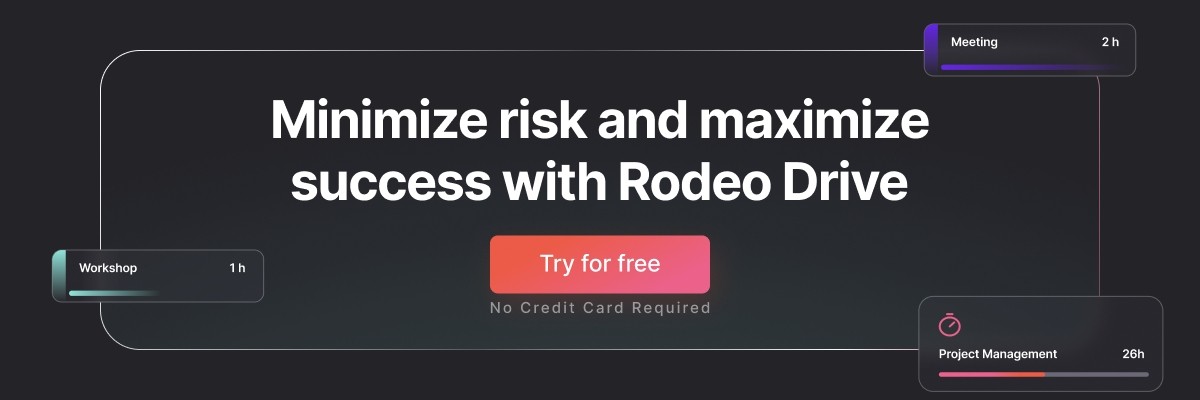Picking the Right Project Success Criteria: A Complete Guide
The goal of any project is to succeed. Although this sounds simple enough, the dynamic nature of projects coupled with differing expectations makes achieving project success a challenging task for a project manager.
Having diverse stakeholders and tight deadlines makes it easy for a project to lose sight of its purpose. What constitutes success? Is it meeting the budget? Satisfying the client? Or maybe improving the team’s future capabilities?
Without clear criteria, projects can conclude with a sense of dissatisfaction, despite meeting some goals. This is where defining project success criteria helps with steering projects toward their intended outcomes.
This article explores project success criteria: what they are, why matter, and how to measure them effectively.
Why is it important to measure project success?
In project management, what gets measured gets done. Measurement offers a tangible way to evaluate whether a project is on track to meet its objectives. Resources are finite in any project environment, so the opportunity cost of a project becoming sidetracked or experiencing resource misallocation can be high.
Measuring your success also has benefits for organizational learning. When you record metrics for all your projects, you can use those insights to optimize resource allocations in future projects. Project managers, teams, and stakeholders alike can learn from the results of each project and apply those lessons to make more informed decisions in the future. Over time, this may lead to higher rates of project success and greater profitability.
Defining and achieving project success criteria, however, is more difficult than it sounds. Just look at the data — a Project Management Institute survey reported that only 28% of application development projects meet their criteria for success.
The reason is that assessing success criteria is not precise. Projects are prone to scope changes and even when that is not the case, the differing expectations of various stakeholders can put projects against multiple, conflicting success criteria.
What are project success criteria?
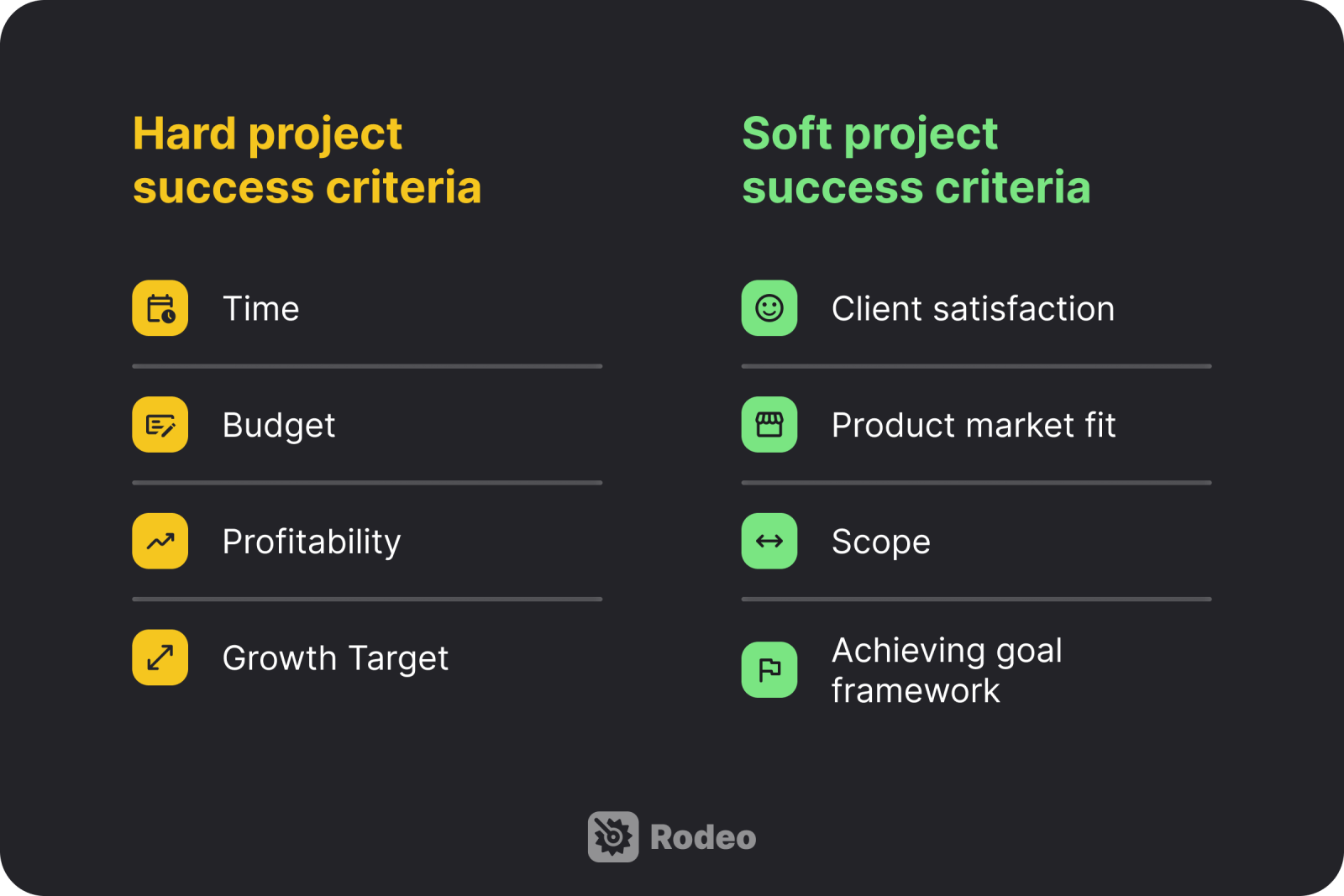
Project success criteria refer to the standards that need to be met for stakeholders to consider a project successful. Outlined at the beginning of the strategic planning phase, these standards depend on the agreement of key decision-makers within an organization.
In the early days of project management, success was simply measured by whether the final product worked. If it did, the project was a success. If it didn’t, the project failed. This, however, was a pretty limited interpretation of success. For one, it didn’t factor in the costs of a project.
Once project management defined the triple constraint (budgets, time, and scope), project success meant completing projects within the triple constraints. It became the project manager’s focus to control processes to meet the triple constraint, while product success after project completion became the responsibility of dedicated product teams.
Hard project success criteria
Hard success criteria are quantitative metrics that measure project success. These are the most visible, concrete indicators of whether a project has met its goals. Typically, these metrics include:
- Time: Did the project meet its deadlines?
- Budget: Did the project stay within its budget?
- Profitability: Did the project achieve its financial goals? Did it reach a sufficient return on investment (ROI) or desired cost savings?
- Growth Target: If the project is something like a marketing campaign or a sales target, did it reach the amount of user growth intended?
For example, a construction project aims to be completed within 12 months for $10 million, achieving an ROI of 20%. These metrics are measurable, hard success criteria.
Soft project success criteria
In contrast, soft success criteria are qualitative goals that focus on the less tangible aspects of a project’s success. These criteria can be harder to pin down, but they are equally important, as they reflect the project’s impact on people or processes.
- Client satisfaction: Are the clients or end-users satisfied with the project’s outcome?
- Product market fit: In the case of an innovative product, are the target customers buying, using, and telling others about the product?
- Scope: Did the project stay within the scope outlined when it began?
- Achieving goal framework: If your team used a goal-setting framework before launching the project, did it meet those goals? For example, if you set stretch goals — which are ambitious but very difficult to achieve goals — then achieving 60-70% of each of those goals can constitute a qualitative success, even if the project didn’t reach the set quantitative metrics.
6 ways to measure project success criteria
There are several frameworks a project management team can use as success criteria. Those frameworks can be used to assess various aspects of success, depending on what the defined priorities of the project are. Here are some examples of project success criteria:
- Pass/fail: Certain criteria can be measured in binary terms. Does the deliverable work? Does it meet regulatory requirements? In those cases, a simple pass/fail is a straightforward measure of project success.
- Cost/benefit or ROI: Either conducting a cost-benefit analysis or calculating ROI quantifies the economic value created by a project relative to its costs, providing a clear measure of its financial success.
- Scale measurement: This is a simple approach where you set up a predefined grading system to rate success criteria like team satisfaction or staying within scope. Scale measurement is useful for providing a quantifiable measure for qualitative success criteria.
- Milestone achievement: Track the completion of important milestones. A project reaching each of its milestones is usually a clear indicator of success.
- Resource utilization: Did the project remain within its scope and use resources efficiently? Sometimes at first glance, a project might meet its deliverables and achieve profitability, but if it draws resources away from other projects and exceeds its timeline, then its ROI might be less than it appears.
- Risk management: Did the project avoid pitfalls that could have resulted in delays, financial loss, legal issues, client loss, or failure?
How to determine which project success criteria are right for your project
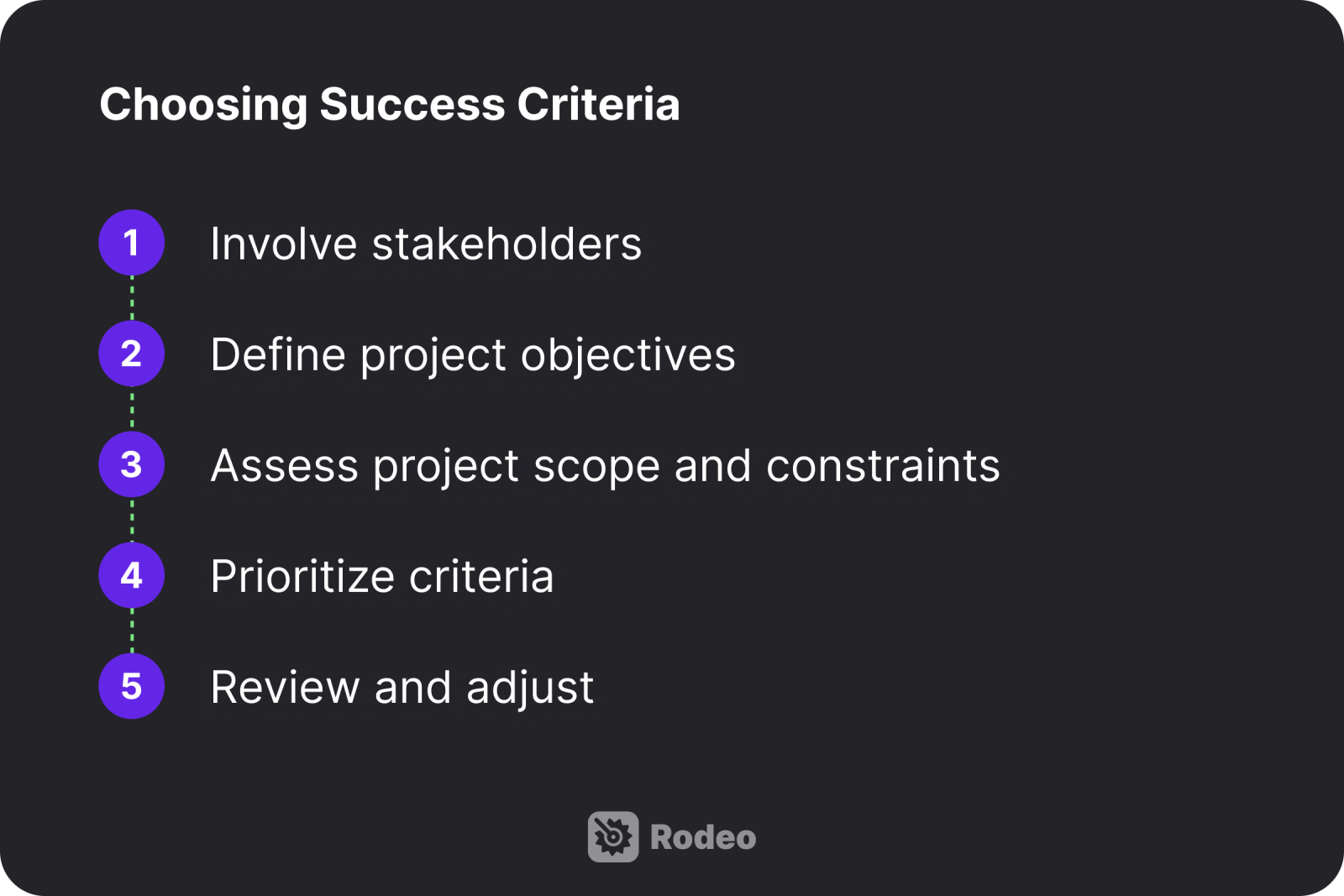
Selecting the right success criteria for a project can be a nuanced process. Different members of an organization might rank the priorities of a project differently. Some might have a different understanding of constraints, and therefore push for a differing scope or objectives. As a project leader, here is how you can approach setting project success criteria:
Involve stakeholders
Engagement with all stakeholders is crucial from the outset. Their insights can help define what different levels of your organization are seeking out of the project. Once these expectations are communicated, the success criteria can be narrowed so that the project plan has a realistic scope while still aligning with business objectives.
Getting stakeholder feedback on these narrowed success criteria secures buy-in for the project and ensures every key player has a clear understanding of what the project is aiming to achieve.
Define project objectives
Once a project leader understands what each stakeholder is seeking from the project, they can outline the objectives that will be the foundation for the project. Objectives should be aligned with the strategic goals of the organization and defined in a way that is SMART: Specific, Measurable, Achievable, Relevant, and Time-bound. This should be the case for both hard and soft project success criteria.
A product team, for example, could make a soft success criterion like “achieving client satisfaction” SMART by aiming to have 85% of clients report themselves as satisfied with the product.
Related: Goals vs. Objectives: Is There a Difference?
Assess project scope and constraints
Having a realistic grasp of the project’s scope and constraints are vital steps in choosing success criteria.
This means you’ll need to conduct a thorough analysis of the project’s deliverables, required resources versus those available, and any other limitations (such as budget caps or fixed deadlines) that will impact project execution. Considering these factors enables project managers to set success criteria that are ambitious yet achievable.
Prioritize your project success criteria
Given resource constraints, not all project success criteria should be prioritized equally. Some will be critical to the project’s overall success, while others might be desirable but not essential. Prioritizing these criteria focuses efforts on what matters most, ensuring that allocated resources are dedicated to key objectives.
Setting vague criteria and priorities can lead to a project becoming directionless or scope creep — where the team takes on an increasing amount of tangential tasks because the core project goals are ill-defined.
Review and adjust
Projects are always dynamic, and what seemed like relevant success criteria at the outset may become less critical as the project progresses. Conduct regular reviews of the project’s progress against its success criteria and make adjustments as necessary.
In the event that a project leader needs to perform change management, reaching out to stakeholders once again and building consensus ensures changes are understood and the project can move forward with internal support.
3 challenges to measuring project success criteria
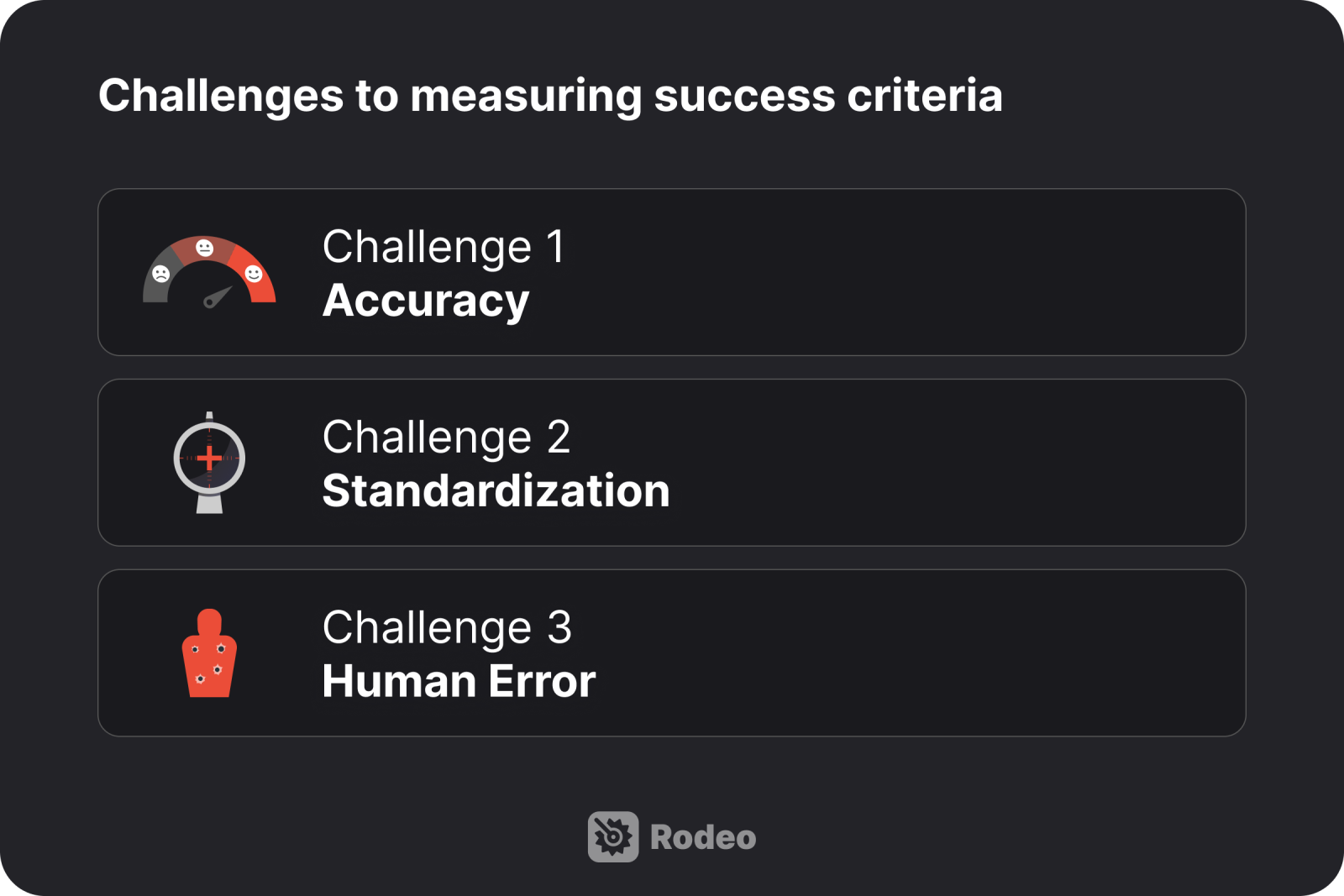
Measuring success criteria has distinct challenges that can skew results and impact decision-making. Here are some of the most common hurdles and how they can impact the reliability of project evaluations:
Challenge 1: Accuracy
Accurately measuring project success is challenging, especially when it comes to soft criteria like satisfaction. Surveys and feedback mechanisms need to be designed carefully to avoid bias and provide an accurate picture of stakeholders’ sentiments.
Challenge 2: Standardization
Comparing the success of different projects across the organization requires a degree of standardization in what project success criteria look like and how they are measured. Developing a standardized framework for project success criteria throughout your organization can create consistency and enable more meaningful analysis.
Challenge 3: Human error
Any measurement process is susceptible to human error, from data entry mistakes to subjective interpretations of qualitative measures. Implementing checks and balances such as data verification procedures and automated workflows where possible, can help mitigate the impact of human error.
Example of project success criteria in action

To illustrate how project success criteria can be applied in practice, consider a company aiming to launch a personal finance app. The project success criteria could look like this:
Hard project success criteria example:
- Launch date: Release the product by Q4 in 2024
- Budget: Complete the project within a budget of $800,000
- Financial target: Achieve an ROI of 25% within the first year of launch, which in this case would mean the app needs to return $1,000,000.
Soft project success criteria example
- Client satisfaction: Achieve an average 4.5-star rating in both the iOS and Android app stores within six months of launch.
- Meet security and compliance requirements: Pass Consumer Financial Protection Bureau privacy regulations on apps handling sensitive personal data.
- Involve employees throughout the organization in the development process: Engage at least 30% of the company’s employees in beta testing or feedback sessions
This is an example of how an organization can define both soft and hard project success criteria for an actionable, balanced measure of what a project aims to achieve.
Use Rodeo Drive to stay aligned with your project success criteria
If you’re looking to make your projects more successful, you’re in luck! Rodeo Drive is a comprehensive platform used by thousands of agencies and creative businesses to lower costs and improve profitability.
With a suite of tools to plan timelines, allocate resources, and track time, project teams use Rodeo Drive to stay aligned and on track to achieve their project success criteria. Here’s how they do it:
Track the status of every project
Managing multiple projects is never an easy feat, but with Rodeo Drive’s Projects page, you can easily access the relevant information for all your ongoing projects at once. You’ll be able to see the project, the client it’s for, and the budget actuals — all in a single view.
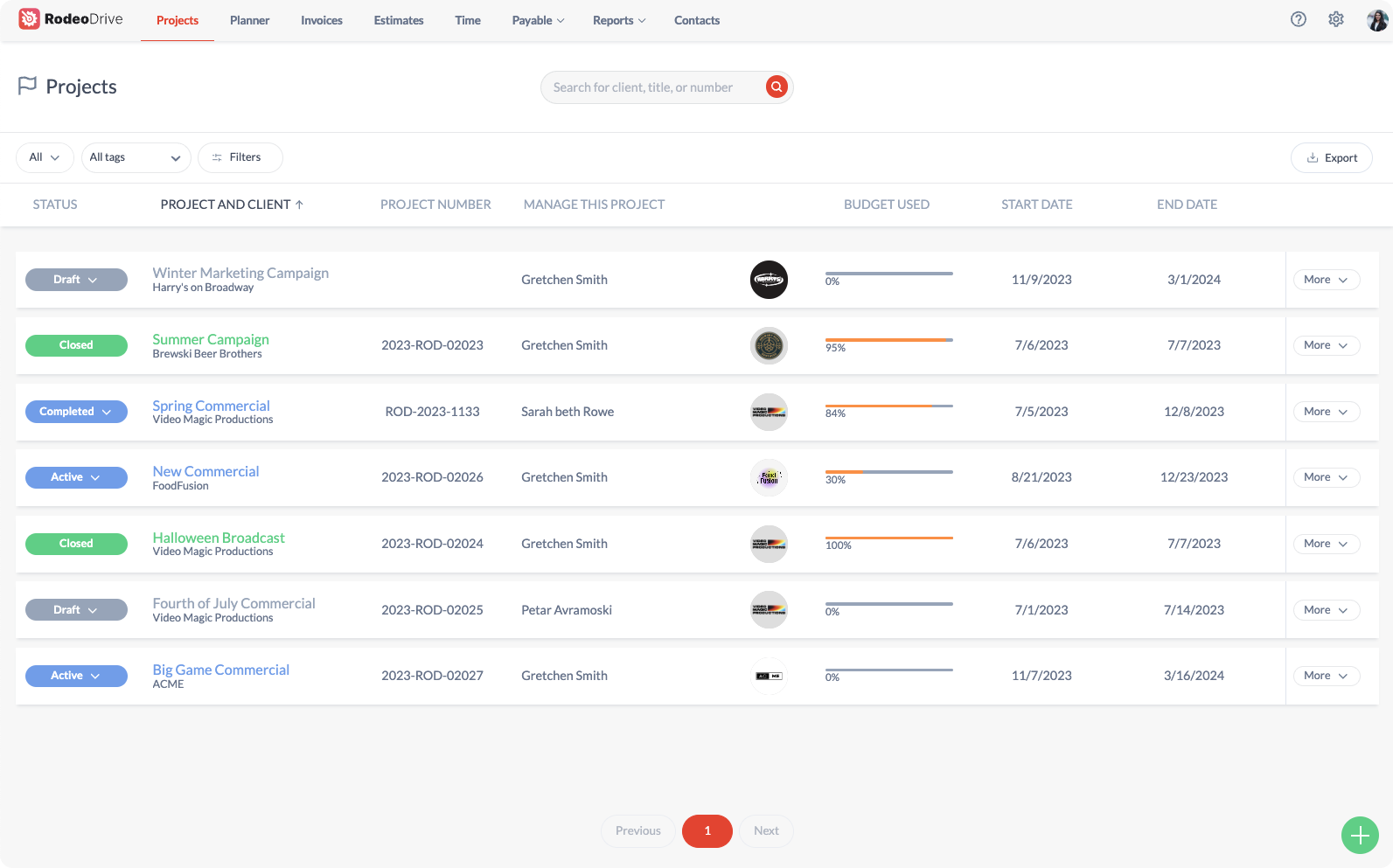
Oversee your team’s progress on all projects in a single view
You can then click on individual projects to get a detailed understanding of project metrics and phases, adjust budgets, add purchase orders, and see how your actual spending on project activities stacks up against your budget estimate. This allows you to keep projects in line with their financial success criteria at every stage.

Monitor your budget actuals in real time using Rodeo Drive
The best part about using Rodeo Drive is your time tracking is connected to your budget, meaning your budget will update in real time to reflect your team’s spending as you work.
Reporting to track costs and workloads
Rodeo Drive offers a suite of three different reports that help you monitor your team’s progress throughout the project lifecycle.
Using Rodeo Drive’s Time report, you can get insights into the time spent on individual project activities and understand their financial impact. For projects that operate on billable hours, this not only allows you to price your work accurately but also enables you to inform stakeholders where the budget is specifically going.
If certain activities are taking up more time than anticipated, having the Time report allows you to identify those inefficiencies and take steps to improve them.
.png)
Gain insights and make informed decisions based on the financial value of your time
Rodeo Drive’s Productivity report provides additional visibility into how your team members are spending their time. You can see how many hours they have scheduled and planned, how many they have still available, and the time they have already spent on projects. This allows you to gauge how many billable and non-billable hours each team member has accumulated.
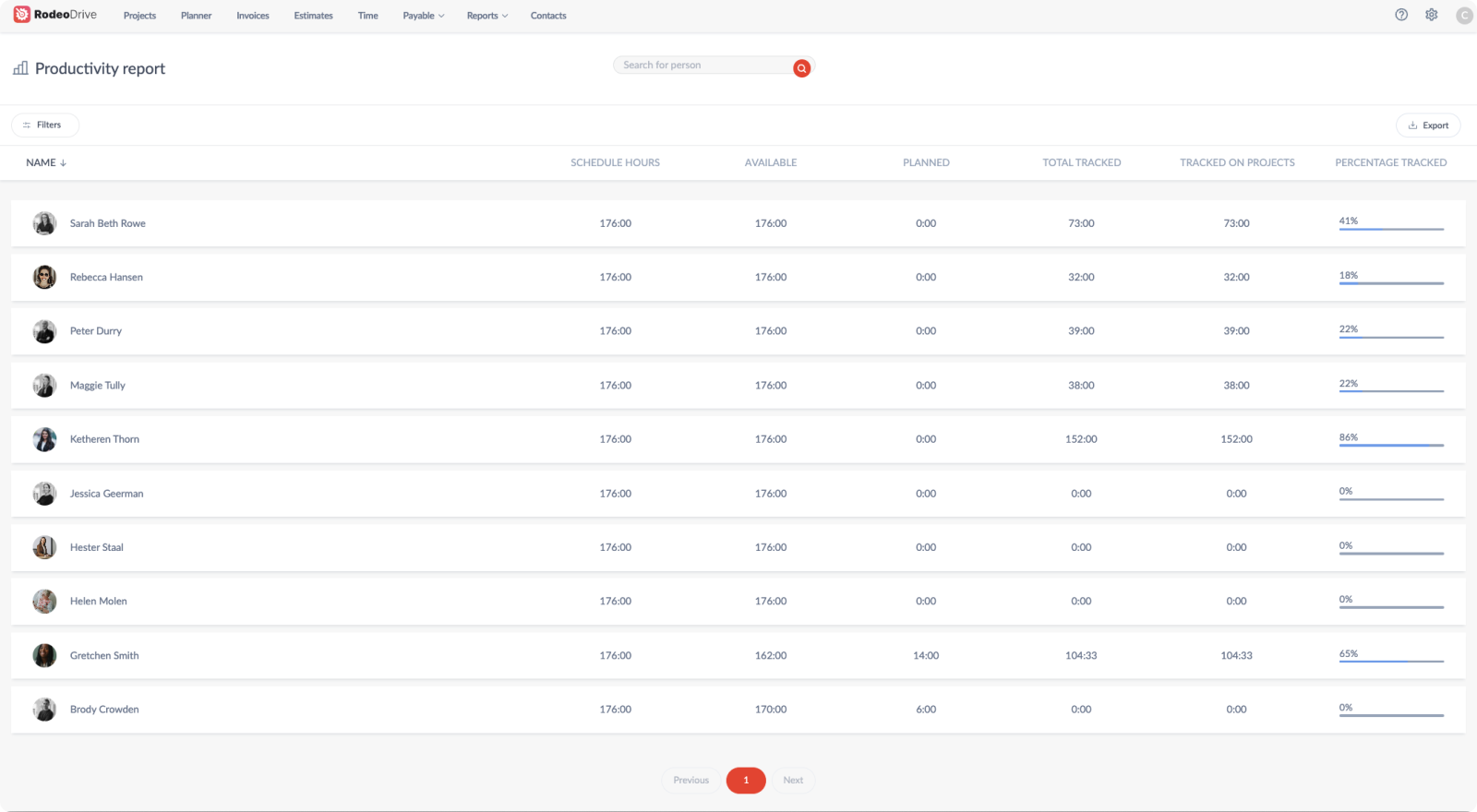
Understand how many hours team members have scheduled and available
Some of Rodeo Drive’s additional features include:
- A timeline-view planner: Review project timelines and ensure activities are aligned with project goals.
- People-view planning: Find available capacity where needed and balance the distribution of workloads to prevent burnout.
- Phased budgeting: Divide budgets to reflect the different phases of a project for better organization and accurate planning.
- In-app time tracking: Rodeo Drive’s set-it-and-forget-it time tracking eliminates the need for timesheets. Use it to track hours and gain an automatic, real-time look into the true cost of your time.
If you’d like to give it a spin, you can use Rodeo Drive for free today. Or if want to better understand whether Rodeo Drive can fit your organization’s particular needs, book a demo with one of our experts.





